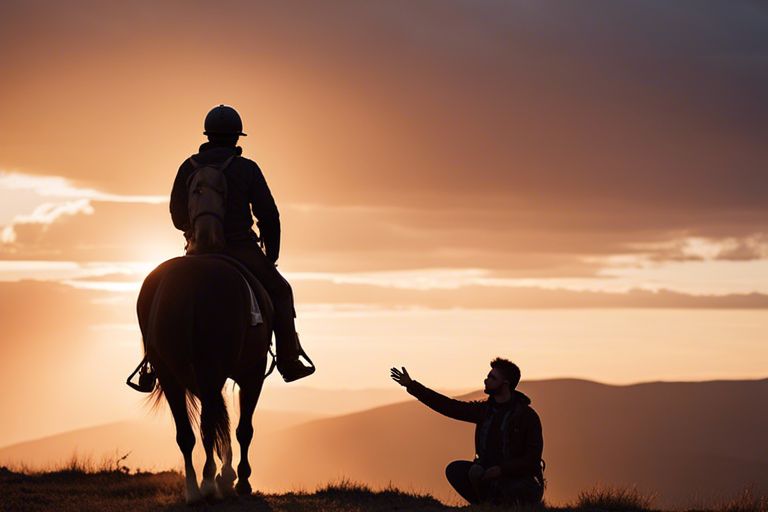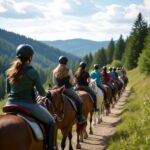There’s an unspoken code among riders when it comes to sharing trails and arenas, keeping you and your horse safe while enjoying your ride. Respect for others, communication, and awareness of your surroundings are key. Learn the rules of the trail to ensure a harmonious experience for everyone. Let’s dive in and explore the important etiquette for riding in shared spaces.


Trail Etiquette
Right of Way
The right of way on trails is an important aspect of trail etiquette. You should always yield to hikers and runners, as well as to any horseback riders traveling uphill. This is because it’s easier for a horse to stop and start moving again when going downhill than uphill.
Speed and Space
Any time you are riding on a trail, you must adjust your speed according to the conditions and the traffic around you. Maintain a safe distance from other riders to prevent accidents. Remember, it’s important to pass others at a slow and controlled pace, announcing your presence to them in advance.
This will help prevent startling not only the horse you are passing but also the rider. Additionally, slow down when going around corners or approaching blind spots to ensure everyone’s safety. Always be alert and considerate of others on the trail.
Arena Etiquette
Now let’s talk about arena etiquette. Just like sharing a trail, sharing an arena with other riders requires certain guidelines to ensure everyone’s safety and enjoyment.
Circle Direction
Any time you enter an arena with multiple riders, make sure to check the designated direction for riding circles. Typically, riders are asked to move in a clockwise or counterclockwise direction to avoid collisions. Always keep an eye out on the direction and follow suit to maintain a smooth flow in the arena.
Passing and Overtaking
Circle slowly and respectfully when overtaking others in the arena. If you are passing a slower rider, announce your intention with a polite request. For example, a simple “May I pass, please?” can go a long way in avoiding surprises and maintaining a harmonious atmosphere in the arena.
Circle back around to give yourself enough space before overtaking, ensuring everyone’s safety and comfort. Bear in mind, it’s crucial to give ample room when passing other riders, so be mindful of your speed and proximity to their horses.
Understanding the dynamics of passing and overtaking in an arena is key to a successful riding experience. Observe the behaviors of fellow riders and always prioritize safety for both yourself and others. By following these recommendations, you’ll contribute to a positive and pleasant arena environment.

Communication is Key
After mastering the basic rules of riding etiquette, the next vital skill for successfully sharing trails and arenas is effective communication. Whether riding on a busy trail or sharing an arena during a lesson, clear communication with other riders is crucial to ensure everyone stays safe and has an enjoyable experience.
Verbal Cues
Cues given through verbal communication are important when sharing spaces with other riders. When approaching someone from behind on a trail, a simple greeting such as “passing on your left” can alert the rider ahead of your presence. Similarly, in an arena, announcing your intentions with phrases like “inside track,” or “jumping the diagonal” can help others understand your plans and adjust accordingly.
Non-Verbal Signals
Cues given through body language and gestures are equally important in communicating with other riders. A friendly nod, a wave, or even making eye contact can convey your intentions or acknowledge someone else’s presence. For example, pointing in the direction you intend to go or making a wide circle with your arm can signal to others your planned route.
Non-verbal signals are particularly crucial when riding in a group or during a lesson where verbal communication may be limited due to distance or noise. Paying attention to the body language of others and being mindful of your own can help prevent misunderstandings and potential accidents.
Communication plays a vital role in maintaining safety and harmony when sharing trails and arenas with other riders. Whether you’re using verbal cues or non-verbal signals, being clear and considerate in your communication can make all the difference in a shared riding space.
Respect for Others
Once again, remember that when riding in shared spaces, it is crucial to show respect for others. This not only includes fellow riders but also other trail users or arena visitors. By following proper riding etiquette, you can help maintain a safe and harmonious environment for everyone.
Horse and Rider Combinations
One key aspect of respecting others on the trails or in the arena is being mindful of different horse and rider combinations. Every horse and rider pair is unique, with varying levels of experience and training. **Being unpredictable can be dangerous**, so always give ample space to others and communicate clearly if you plan to pass or approach closely.
Different Disciplines and Breeds
Others may be practicing **different disciplines or riding different breeds**. Some disciplines require specific patterns or jumps set up in the arena, so make sure to be aware of these and adjust your route accordingly. **Each breed may have specific training needs or sensitivities**, so it’s vital to give them space and not startle them during your ride.
Disciplines and breeds that differ from your own bring diversity to the equestrian community, so embrace and learn from these differences. Understanding and respecting others’ preferences and needs make for a more enjoyable and inclusive riding environment for everyone.

Safety First
Unlike the controlled environment of a riding arena, sharing trails with other riders can present unique challenges and hazards. It’s important to prioritize safety to ensure an enjoyable experience for everyone on the trail.
Hazard Awareness
One important aspect of riding safely on trails is being aware of potential hazards. Keep an eye out for slippery or muddy areas, fallen branches, wildlife, and other riders. By staying alert and anticipating possible dangers, you can avoid accidents and keep yourself and your horse safe.
Emergency Procedures
An important part of safety while riding is knowing what to do in case of an emergency. Make sure you are familiar with basic first aid techniques and carry a fully stocked emergency kit with you on every ride. In the event of an accident, remain calm and assess the situation before taking action.
For instance, in the case of a fall or injury, it’s crucial to prioritize your own safety before attempting to help your horse. Always have a plan in place for contacting emergency services and be prepared to provide accurate information about your location on the trail.
Environmental Considerations
All riders should be mindful of environmental considerations when out on the trails or in the arenas. This means taking care of the natural surroundings and being responsible for the impact you have on the environment.
Trail Maintenance
For trail maintenance, make sure you stick to designated trails to avoid damaging vegetation and causing erosion. If you come across any obstacles on the trail, report them to the appropriate authorities so they can be addressed. **Remember**: maintaining the trails ensures they can be enjoyed by all riders for years to come.
Waste Disposal
The proper disposal of waste is crucial when riding in natural settings. **Avoid** leaving any trash behind, including food wrappers or empty water bottles. **Dispose** of your waste in designated bins or take it with you to properly discard it later. **Leaving** waste behind can harm wildlife, pollute water sources, and disrupt the natural balance of the environment. **Always** aim to leave the area cleaner than you found it.
Final Words
Following this set of riding etiquette rules will help ensure a safe and enjoyable experience for everyone sharing trails and arenas. By being mindful of others, communicating effectively, and respecting the space and boundaries of fellow riders, you can help create a harmonious environment for all horse enthusiasts. Recall, good manners and consideration go a long way in fostering positive interactions in the equestrian community.
Q: What is riding etiquette?
A: Riding etiquette refers to the established rules and practices that ensure safe and respectful interactions between riders when sharing trails and arenas.
Q: Why is riding etiquette important?
A: Riding etiquette is important because it helps prevent accidents, promotes harmony among riders, and ensures that everyone can enjoy their time in shared riding spaces.
Q: What are some common rules of riding etiquette?
A: Common rules of riding etiquette include yielding to faster riders, communicating with other riders, picking up after your horse, and respecting trail and arena rules.
Q: How should riders communicate on the trail or in the arena?
A: Riders should communicate by using verbal cues, hand signals, or friendly gestures to indicate their intentions or to alert others to potential hazards.
Q: What should riders do if they encounter a challenging situation on the trail or in the arena?
A: If riders encounter a challenging situation, they should remain calm, communicate with others, and work together to find a safe resolution, always prioritizing the well-being of themselves, their horses, and fellow riders.










